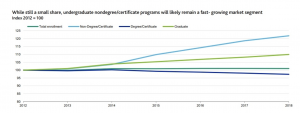
Online learning offers a massive opportunity for associations. They are well placed to capture the shift toward skills-based training. It is clear that professionals and employers are demanding an unbundled learning experience. This transition to unbundled learning creates both an opportunity for and a threat to associations.
If associations adapt their learning design strategy, they have a massive opportunity. If they stick with their traditional approach, training companies and employers will fill the gap, leaving associations behind.
In fact, many institutions and training companies already offer unbundled training programs. They are breaking the learning down into smaller and smaller packages. Instead of a four-year degree, universities have unbundled it to include part-time study or certificates. Associations likewise can unbundle learning by turning certificates into micro-credentials or boot camps.
The shift to unbundled learning is partly in response to higher education trends. The data clearly shows interest in non-degree/non-credit programs, as reported by Inside Higher Ed. Associations are well placed to capture this growth.

Source: “Alternative Credentials on the Rise” by Paul Fain, Inside Higher Ed, Aug 27, 2020.
Associations’ unbundled learning programs also appeal to a larger segment of the population than traditional degrees. When surveyed, Strada found 63 percent of Americans prefer non-credit or skills-based learning. In particular, Americans with a high school education or less considered stackability as a selling feature. They want to be able to gain a relevant skill immediately, then have the option to pursue a larger certificate.
As large corporations such as Walmart and Amazon offer employee tuition coverage for certificates, the market for unbundled learning will only continue to grow. Let’s explore how associations can answer these market needs with unbundled learning pathways.
Traditional Pathways vs. Unbundled Learning Pathways
Traditionally, associations performed a job analysis to discover key skills and competencies. Then they built a competency framework to create certificate programs.
For associations, unbundled learning programs grow out of these traditional competency-based frameworks. Even though they have been unbundled, these programs still follow best practices in curriculum development, such as sequencing learning objectives.
At the same time, unbundled learning pathways recognize that some skills can be learned simultaneously. For example, HR professionals can learn about HR policy and business practices at the same time. Unbundled learning programs create personalized learning pathways by letting learners take courses simultaneously.
The Coronavirus pandemic may have accelerated the unbundled learning trend, but the trend has been reshaping the association training landscape for years. BenchPrep data shows that the number of active learning days has been dropping steadily. This 63 percent drop in active learning days during a course shows the unbundled learning trend in action.

3 Steps for Building an Unbundled Learning Program
Unbundled learning programs may grow out of an existing certificate program; however, they have one important difference—the learner journey is not linear. Instead of training for years, unbundled learning programs promise competency in a matter of days. To design a program around competency, organizations need to take three important steps.
STEP 1: Shift Your Mindset
Currently, many associations focus on improving their existing certificate programs. But they need to make a mindset shift. They need to start asking, “Where do we want our programs to be in three to five years?” Then they can start working backwards from this goal.
Associations’ new goal may be to move toward unbundled learning. Strada’s survey data clearly shows Americans prefer it. In fact, 39 percent only care about learning the skills, while another 24 percent are happy with non-degree options. In total, 63 percent of Americans only care about one thing: competency.
This data suggests associations should focus less on their main certificate and instead focus on competency. When associations change their focus, they also may find their goals shifting.
STEP 2: Map Your Content to the Learner Journey
The structure is important in unbundled learning experiences. Every learner has a goal for their journey. Unbundled learning should map training to these goals.
For example, learners may want to get a new job, earn a promotion, or change their career trajectory. Associations’ unbundled pathways should show learners how each course matches their goals.
Associations can make a map by working backwards from their learners’ goals. Then they will be able to see how their content can help. This process also will allow associations to see what content can be consumed in parallel and what content needs to be consumed sequentially. Without this knowledge, your learners will not be able to create a personalized learning pathway.
STEP 3: Choose the Right Technology
Organizations don’t have to work on unbundling their programs alone. Learning technology has come a long way from the digital textbook-style learning management system (LMS).
Technology has caught up. Learning technology vendors offer many different options for creating an unbundled learning program. They offer gamified solutions, artificial intelligence-driven personalized learning, and microlearning platforms.
This is good news for associations. They can continue doing what they do best—building competency frameworks. Then their learning tech partner can help them unbundle it. They just need to choose a partner to help them execute their vision for unbundled learning.
The Advantages of Unbundling Learning for Associations
Building an unbundled learning program may look like a lot of work, but there is good news. Associations are already well-positioned to make the transition. Luckily, they often have already created competency frameworks. Then it is relatively easy to unbundle the learning into specific competencies.
For associations, the advantages of unbundled learning outweigh the effort:
- Unbundled learning products may appeal to new market segments and attract new members, including younger demographics.
- Learners prefer unbundled learning. Ultimately, associations want to help their members.
- An unbundled learning infrastructure allows associations to develop other continuing education offerings. They can grow their course offerings more easily.
A learner may not be ready for full certification, but they may be ready for a course. Unbundled learning offers the flexibility associations need to serve their members best and stay competitive in the education marketplace.




